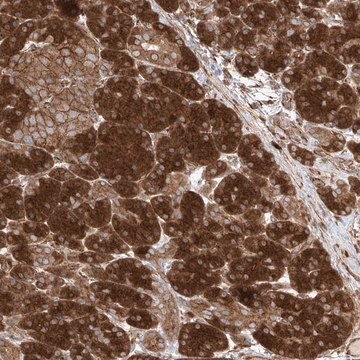Recommended Products
capacity
0.2 mg loading(0.2 mg D-Ribulose 1,5-Diphosphate Carboxylase (Rubisco))
storage temp.
2-8°C
Looking for similar products? Visit Product Comparison Guide
General description
RuBisCO (Ribulose-1,5-bisphosphate carboxylase/oxygenase) is the most abundant protein in plants, and it may be the most abundant protein on Earth. RuBisCO is an enzyme that is used in the Calvin cycle to catalyze the first major step of carbon fixation, a process by which the atoms of atmospheric carbon dioxide are made available to organisms in the form of energy-rich molecules such as sucrose. RuBisCO, while being the key enzyme in photosynthetic carbon assimilation in green leaves, is the main obstacle in plant proteomics. It constitutes about 40% of the total protein mass in green leaves, thus interfering with proteomics studies such as LC-MS/MS and 2D-gel electrophoresis. To meet the needs for specifically and effectively separating RuBisCO from other plant proteins, Sigma developed a novel immunoaffinity matrix based on the IgY antibodies cross-linked to microbeads, which specifically removes RuBisCO protein from plant extract.
Application
Seppro® Rubisco, spin columns (capacity: ∼0.2 mg of Rubisco) may be used in plant proteomics research to effect IgY-mediated immune affinity removal of RuBisCO (Ribulose-1,5-bisphosphate carboxylase/oxygenase) from plant tissue extracts via liquid chromatography.
Legal Information
Seppro is a registered trademark of Merck KGaA, Darmstadt, Germany
Kit Components Also Available Separately
Product No.
Description
SDS
Storage Class Code
10 - Combustible liquids
Certificates of Analysis (COA)
Search for Certificates of Analysis (COA) by entering the products Lot/Batch Number. Lot and Batch Numbers can be found on a product’s label following the words ‘Lot’ or ‘Batch’.
Already Own This Product?
Find documentation for the products that you have recently purchased in the Document Library.
Customers Also Viewed
Martin Černý et al.
Journal of experimental botany, 64(14), 4193-4206 (2013-09-26)
In plants, numerous developmental processes are controlled by cytokinin (CK) levels and their ratios to levels of other hormones. While molecular mechanisms underlying the regulatory roles of CKs have been intensely researched, proteomic and metabolomic responses to CK deficiency are
The Nucleolar Fibrillarin Protein Is Required for Helper Virus-Independent Long-Distance Trafficking of a Subviral Satellite RNA in Plants
Chang CH, et al.
Plant Cell (2016)
Ankita Sehrawat et al.
Frontiers in plant science, 4, 342-342 (2013-09-14)
Although in the last few years good number of S-nitrosylated proteins are identified but information on endogenous targets is still limiting. Therefore, an attempt is made to decipher NO signaling in cold treated Brassica juncea seedlings. Treatment of seedlings with
Renato Millioni et al.
PloS one, 6(5), e19603-e19603 (2011-05-17)
To date, the complexity of the plasma proteome exceeds the analytical capacity of conventional approaches to isolate lower abundance proteins that may prove to be informative biomarkers. Only complex multistep separation strategies have been able to detect a substantial number
Shasha Zhou et al.
Plant science : an international journal of experimental plant biology, 236, 44-60 (2015-05-31)
Water use efficiency is an important indicator for plant adaptation and resistance to drought conditions. We previously found that under moderate drought stress, the water use efficiency of cv. 'Qinguan' apple (Malus domestica Borkh.) (tolerant to drought) was enhanced, while
Our team of scientists has experience in all areas of research including Life Science, Material Science, Chemical Synthesis, Chromatography, Analytical and many others.
Contact Technical Service










